
Overview
The article "10 Essential Internal Linking Strategies for DTC Brand Success" centers on illuminating effective internal linking strategies that significantly enhance the SEO performance and conversion rates of Direct-to-Consumer (DTC) brands. It articulates best practices such as:
- Utilizing descriptive anchor text
- Prioritizing high-traffic pages
- Conducting regular audits of links
These strategies collectively bolster site navigation, elevate user engagement, and enhance search engine visibility, ultimately driving higher conversion rates.
Introduction
A well-crafted internal linking strategy is a game-changer for DTC brands striving for SEO excellence and increased conversions. By interlinking relevant content, these brands can enhance their website's visibility and user navigation, ultimately guiding visitors through the sales funnel more effectively.
However, with the sheer volume of content available, how can brands ensure their internal links are not just present, but optimized to drive engagement and sales?
This article delves into ten essential internal linking strategies that can elevate a DTC brand's online presence and performance.
Parah Group: Comprehensive Internal Linking Strategies for SEO Success
A robust internal linking strategy is essential for DTC brands seeking SEO success and improved conversion rates. By strategically linking related content, brands enhance their website's crawlability, making it easier for search engines to index and comprehend site structure. This not only improves but also facilitates navigation, directing visitors through the sales funnel more efficiently.
Internal links are crucial for distributing link equity across important pages, significantly impacting conversion rates. A well-organized linking system can lower bounce rates and extend the duration visitors spend on the site—both critical indicators of engagement. Studies indicate that eCommerce conversion rates generally hover around 3.56%; however, effective linking within a website can assist brands in elevating these figures by helping individuals discover relevant content swiftly and effortlessly.
Successful examples of linking strategies include premium fashion brands that leverage detailed product descriptions and high-quality visuals. These elements not only enhance user experience but also foster trust. Such brands frequently report increased sales due to improved navigation and accessibility to product information.
Experts emphasize that internal linking strategies should be a top priority for DTC brands. The tactical application of within-site connections ensures that connection value is efficiently distributed across the platform, generating a collaborative effect that enhances overall performance. As industry experts observe, internal linking strategies are minor yet influential components of a comprehensive SEO strategy, capable of driving substantial improvements in both user experience and conversion rates.
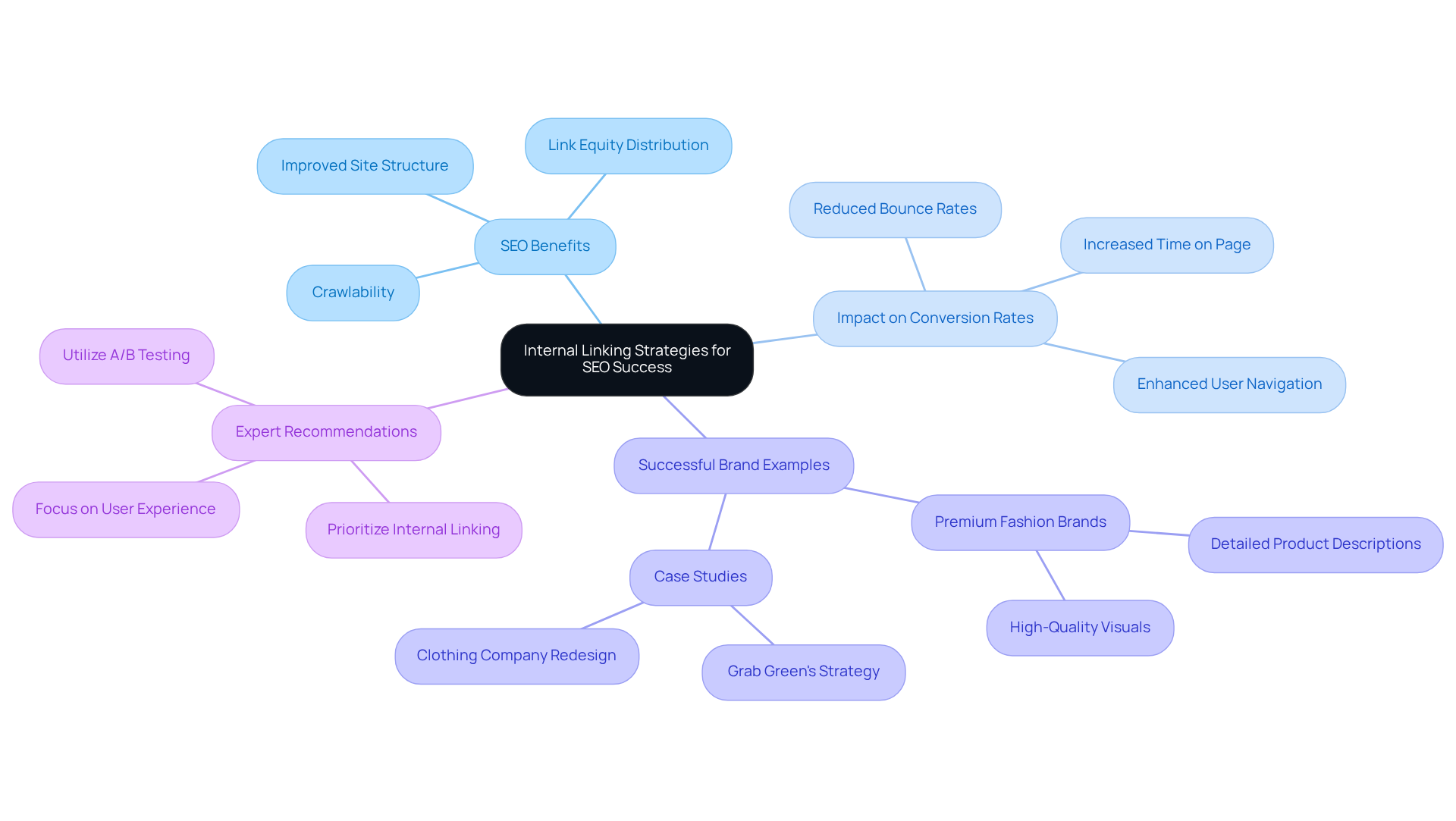
Clearscope.io: 12 Proven Internal Linking Best Practices to Enhance SEO
- Use Descriptive Anchor Text: Employ specific and relevant anchor text to provide context for linked pages. This approach assists both individuals and search engines in comprehending the linked page's content, thereby enhancing clarity and relevance. Avoid vague phrases like 'click here' to improve user experience and SEO performance.
- Connection to High-Priority Pages: Strategically connect to your most important pages to pass authority and enhance their ranking potential. This practice aids in efficiently distributing your site's authority, ensuring that essential material receives the visibility it merits.
- Ensure Relevance: Always connect to material that is pertinent to the surrounding text. This not only assists in navigation for individuals but also strengthens the contextual relationship between pages through effective internal linking strategies, which is essential for SEO.
- Maintain Natural Flow: Incorporate internal connections smoothly within your material. A natural flow in writing enhances readability and keeps users engaged, which is crucial for implementing effective internal linking strategies that encourage them to explore more of your site.
- Regularly Audit Internal Connections: Conduct routine reviews to identify and fix broken connections or outdated content. Regular checks ensure that your internal linking strategies are effective and relevant, which is essential for maintaining site quality.
- Combine Internal and External Connections: Balance your in-house connecting strategy with external references to authoritative sources. Implementing internal linking strategies enriches your content and boosts credibility and trust among individuals.
- Avoid Excessive Connections: Limit the quantity of references on a single page to prevent overwhelming users. A good rule of thumb is to aim for 2-5 internal connections per 1,000 words, ensuring that each connection serves a clear purpose.
- Update Old Content: Revise older articles to incorporate references to new content. This practice utilizes internal linking strategies to maintain your site’s freshness and motivate visitors to interact with your latest offerings, enhancing overall site performance.
- Create a Logical Hierarchy: Establish a clear hierarchy of links that reflects your site's structure. This assists in navigation for both individuals and search engines through effective internal linking strategies, making it easier to locate important content.
- Use Breadcrumbs: Implement breadcrumb navigation to enhance visitor experience. Breadcrumbs provide a clear path back to previous pages, improving site usability and helping users understand their location within your site.
- Connection to Cornerstone Content: Ensure that your cornerstone content—key pages that define your brand and offerings—receives sufficient links within the site. This reinforces their importance and helps improve their search rankings by utilizing internal linking strategies.
- Monitor Performance: Regularly track the performance of your internal connections. Use analytics tools to assess how well your links are driving traffic and engagement, allowing for to your strategy.
By adopting these best practices, DTC brands can significantly boost their SEO performance, enhance customer experience, and ultimately drive more conversions.
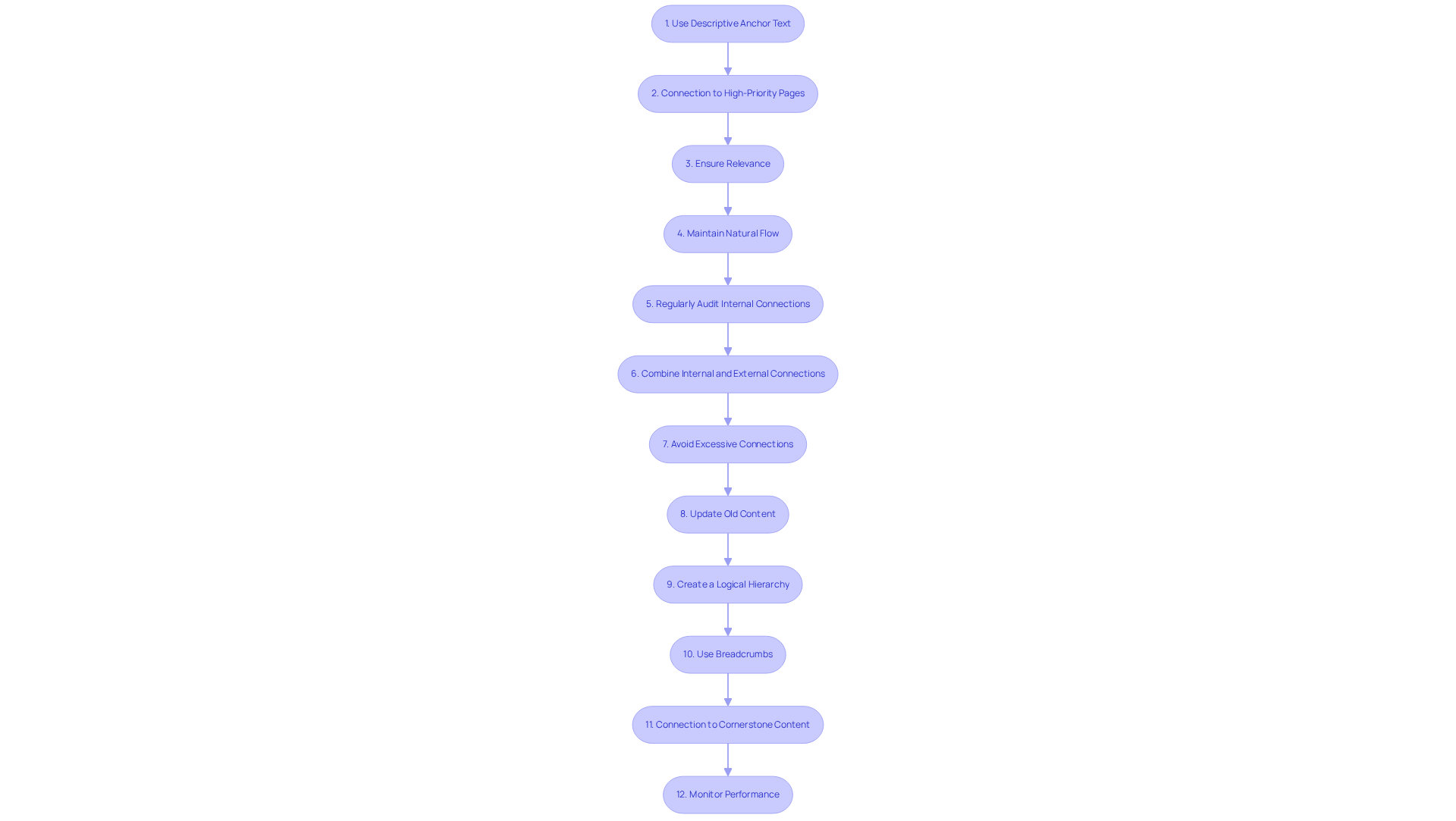
Network Solutions: How to Create a Strong Internal Linking Strategy for Your Website
To establish a robust internal linking strategy, consider the following steps:
- Identify Key Pages: Focus on pages that require increased visibility, such as those with high traffic or conversion potential. Successful DTC brands prioritize linking to their best-performing product pages to enhance visibility and drive sales.
- Map Your Website Structure: Visualizing your website's architecture clarifies how pages interconnect. A well-structured site resembles a pyramid, with the homepage at the top, followed by categories and individual posts, facilitating easier navigation for both users and search engines.
- Analyze Existing Links: Utilize tools like Screaming Frog or Semrush to audit your current internal linking structure. These tools identify orphaned pages and highlight areas needing enhancement, ensuring that all valuable material is easily accessible.
- Prioritize High-Traffic and High-Converting Pages: Regularly assess which pages drive the most traffic and conversions. Linking to these pages not only boosts their authority but also enhances overall site performance, as Google tends to favor well-linked content. Internal links can help reduce bounce rates and increase time-on-site, further improving SEO performance.
- Update Your Linking Strategy: Continuously based on performance metrics. Regular evaluations help maintain an effective structure as your content evolves, ensuring that new and existing pages remain interconnected.
- Ensure Functional and Relevant Links: Regularly check that all within-site links are operational and contextually relevant. This practice improves user experience and aids search engines in crawling your site efficiently.
Experts stress that a well-planned internal linking strategy can significantly improve SEO performance. As Hubert Bieluczyk, founder of The SEO Corner, states, 'Internal linking is one of the most overlooked but powerful aspects of SEO.' Additionally, Jennifer Mathews, a renowned SEO strategist, emphasizes that 'without links, your content can’t rank!' By implementing these strategies, DTC brands can effectively boost their online presence and drive sustainable growth. For instance, Dr. David McInnis Orthodontics attained a consistent flow of organic leads following the reorganization of their website for search intent alignment and enhancing local SEO, showcasing the concrete advantages of implementing internal linking strategies.
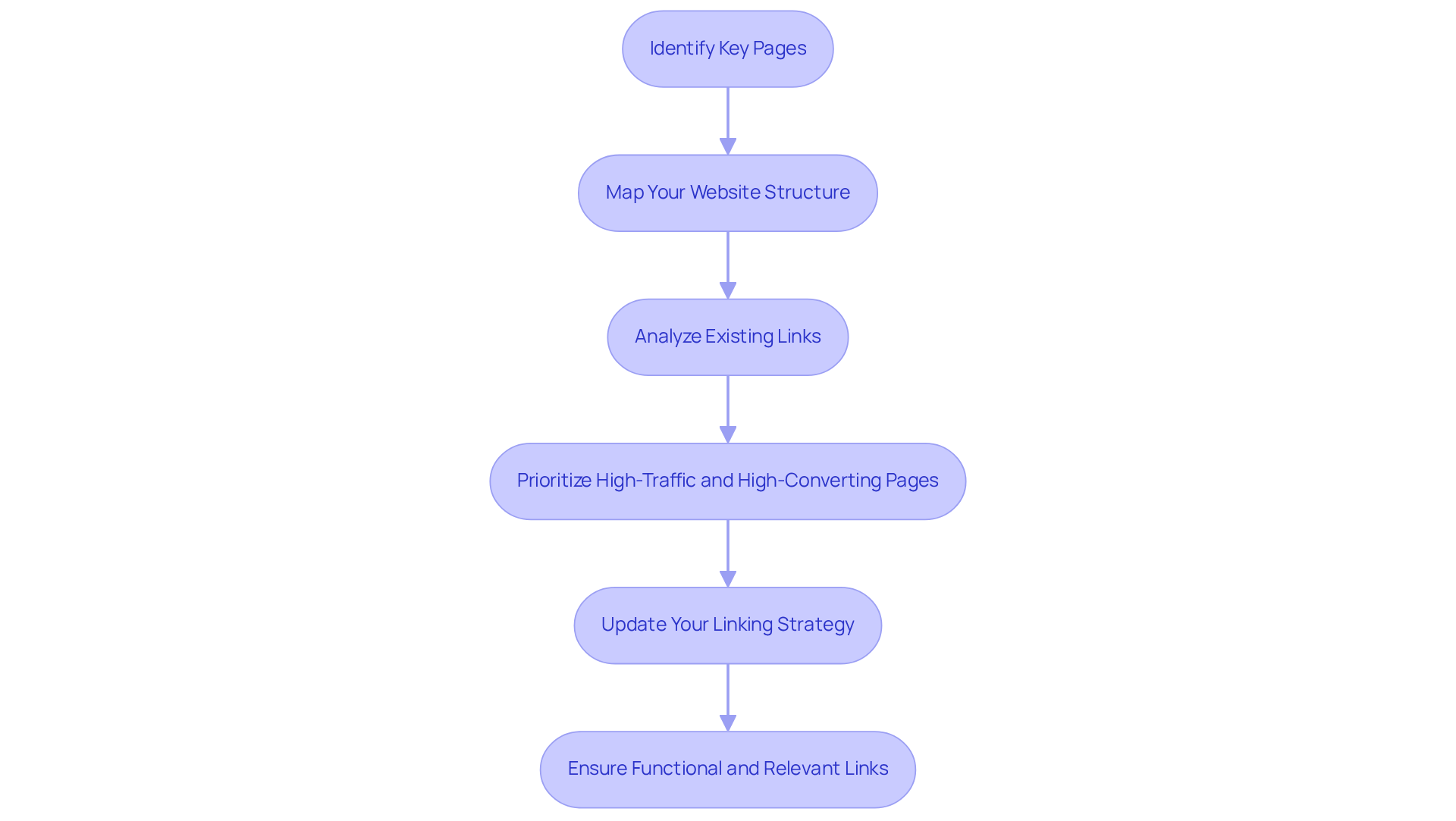
Yoast: Internal Linking for SEO - Why It Matters and How to Implement It
Internal linking strategies are essential for SEO, as they allow search engines to understand your website's architecture and the interconnections among various pages. Internal linking strategies that are well-implemented not only boost visibility but also enhance user engagement metrics, leading to higher conversion rates. As Mary Kate Mack states, "Internal links play a crucial role in SEO by helping search engines discover, index, and understand the structure of your website." To implement effective internal linking, consider these strategies:
- Create a Content Map: Visualize the connections between your pages to pinpoint opportunities for linking.
- Use Relevant Keywords in Anchor Text: This helps search engines grasp the context of the linked material, enhancing its discoverability.
- Link to Related Articles: Encourage users to delve deeper into your content, which can reduce bounce rates and increase time spent on your site.
- Ensure Natural Placement: Integrate links seamlessly within your content to maintain a smooth reading experience.
- Consistently Examine and Refresh Connections: Keep your internal links relevant and functional to support ongoing SEO efforts.
DTC brands that effectively use internal linking strategies often witness substantial improvements in engagement metrics, such as increased page views and decreased bounce rates. For example, brands that utilize contextual links within their content have reported enhanced navigation and user satisfaction, ultimately driving higher conversion rates. Tools like Yoast SEO Premium and Ahrefs' Site Audit tool can assist in efficiently. Moreover, addressing orphaned content—pages lacking links directing to them—can further elevate your site's SEO performance.
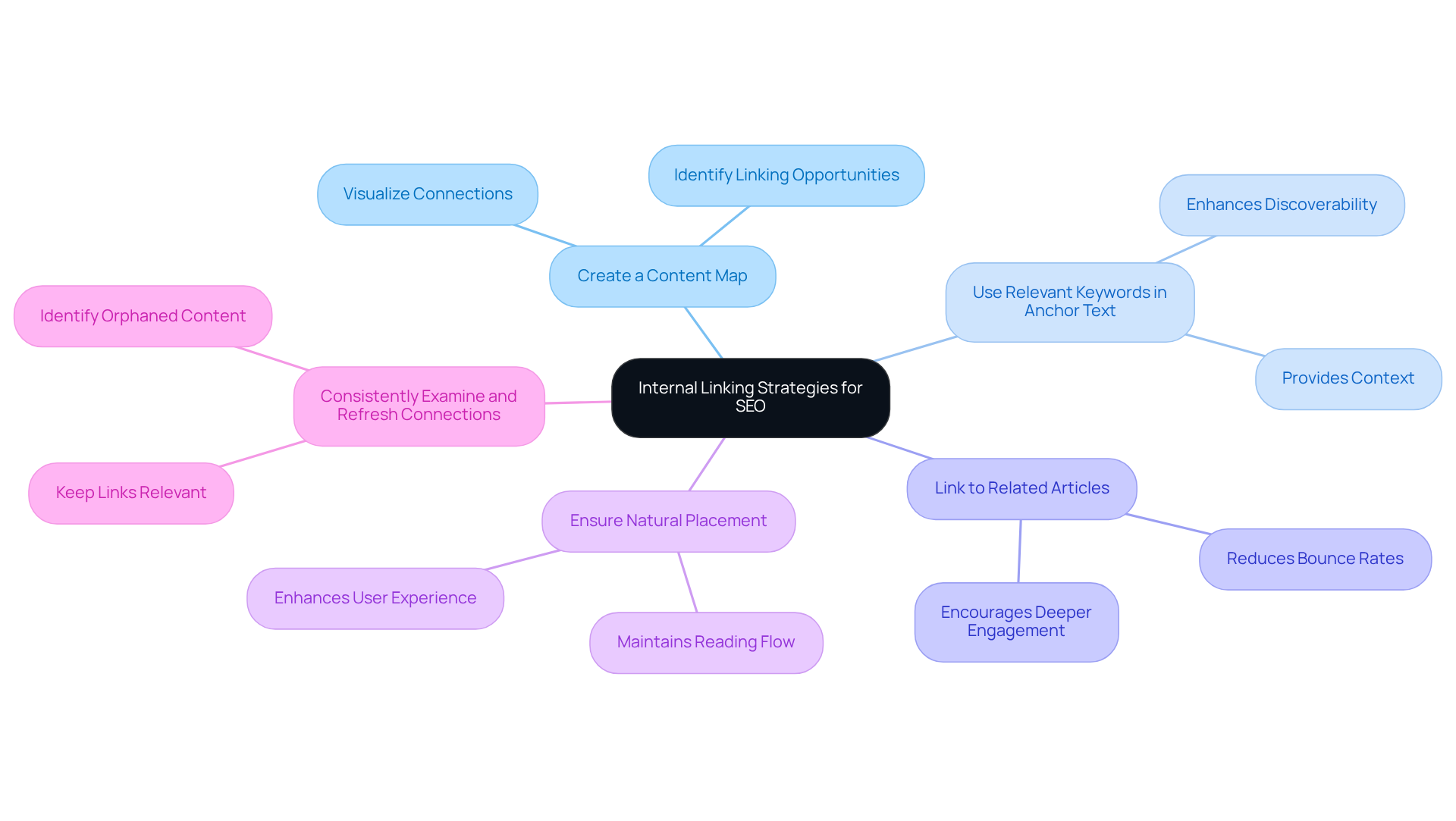
Understanding Topic Clusters: A Key Component of Effective Internal Linking
Topic clusters involve the strategic arrangement of related materials around a central pillar page, a method that significantly by indicating relevance to search engines and improving user experience through intuitive navigation. Research demonstrates that efficient linking within a site can lead to shorter bounce rates and extended session durations—critical factors for retaining visitors.
To implement topic clusters effectively, follow these steps:
- Identify a core topic that resonates with your audience.
- Create supplementary content that references the pillar page, ensuring each element is interconnected.
- Maintain a balanced distribution of internal links across all cluster articles to reinforce the overall structure.
This approach not only boosts search visibility through internal linking strategies but also fosters a seamless experience, ultimately driving higher conversion rates. DTC brands that have adopted internal linking strategies report substantial improvements in audience interaction and site authority, underscoring the power of well-organized information ecosystems.
For instance, utilizing topic clusters can lead to shorter bounce rates and longer session times, highlighting the critical role of user experience (UX) in visitor retention; indeed, 88% of people are less likely to return to a site after encountering poor UX.
Tools such as the Hubspot Topic Cluster Tool and SEMrush Keyword Magic can facilitate the effective construction of these clusters. As Adam Tanguay notes, 'One of the best ways to do this is by structuring your material into topic clusters.

Identifying Cornerstone Content: Prioritizing Internal Links for Maximum Impact
Cornerstone material serves as the foundational articles on your site, addressing broad topics essential to your brand. To effectively identify and prioritize this content, consider the following steps:
- Analyze Existing Content: Review your current articles to pinpoint comprehensive pieces that provide in-depth coverage of key subjects relevant to your audience.
- Internal linking strategies: Ensure these cornerstone articles are linked to regularly from various pages across your site, enhancing their visibility and accessibility.
- Regular Updates: Keep cornerstone material fresh and relevant by updating it periodically, which not only enhances user experience but also signals to search engines that your information is current.
- Utilize Related Articles: Use links from related articles to , creating a network of connections that enhances overall site authority.
Statistics indicate that the use of internal linking strategies within a website can significantly enhance traffic to essential material. For instance, brands that utilize internal linking strategies often experience traffic increases of up to 88% within weeks. Moreover, businesses engaging in blogging obtain 97% more backlinks to their site, underscoring the importance of material creation in facilitating link acquisition. This approach not only improves user navigation but also boosts SEO effectiveness by utilizing internal linking strategies, as search engines favor well-linked material.
DTC brands, such as those highlighted in Parah Group's case studies, have successfully employed internal linking strategies to enhance their foundational material, resulting in increased search visibility and a steady influx of organic leads. For example, a $30M apparel brand that partnered with Parah Group witnessed a 35% increase in conversion rates after implementing optimized internal linking alongside other CRO strategies. By prioritizing essential materials and utilizing internal linking strategies effectively, brands can achieve substantial SEO success and drive meaningful traffic to their most valuable resources.
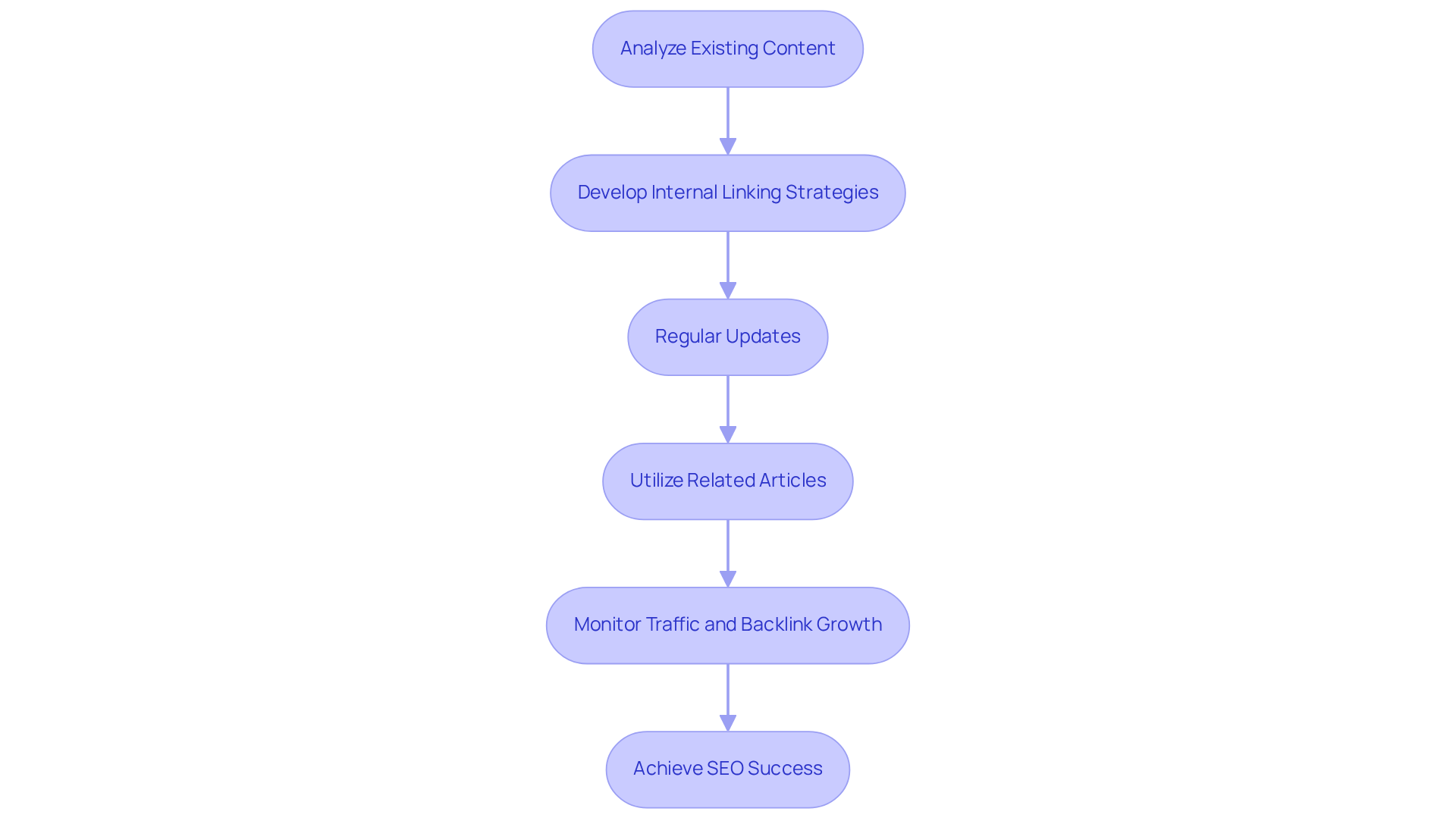
Using Descriptive Anchor Text: Enhancing User Experience and SEO
Descriptive anchor text is essential for providing context to linked pages, significantly enhancing user experience and search engine optimization (SEO). To utilize anchor text effectively, consider the following strategies:
- Ensure that it accurately represents the content of the linked page, establishing relevance right from the outset.
- Avoid generic phrases such as 'click here,' which fail to convey meaningful information.
- Employ a diverse range of anchor text to prevent over-optimization, thereby safeguarding your SEO efforts.
- Keep the anchor text to the surrounding content, ensuring clarity and focus.
By adhering to these principles, you can maximize the impact of your anchor text, ultimately driving better results.
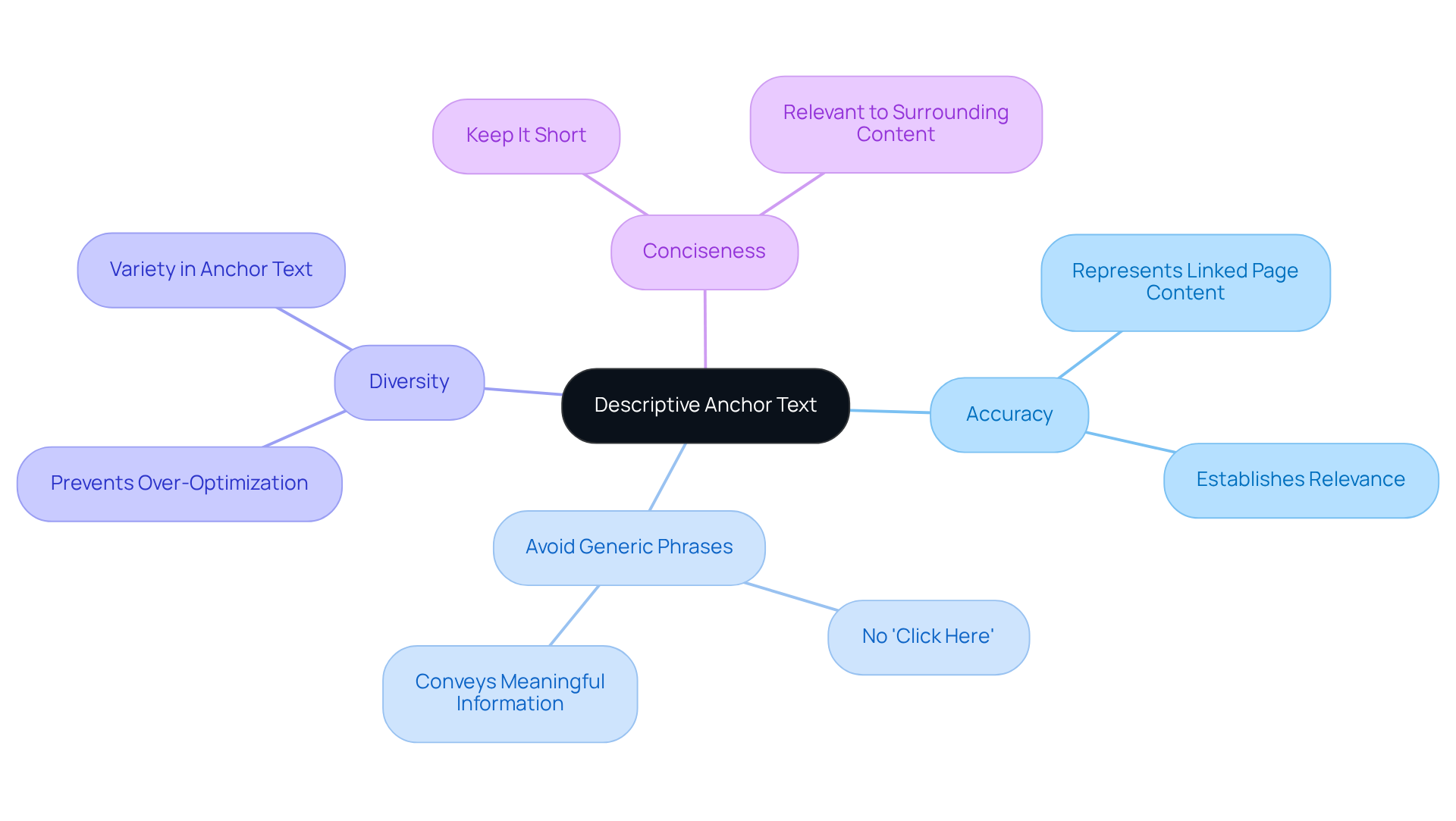
Creating a Silo Structure: Organizing Content for Better SEO Performance
A silo structure serves as a powerful tool for organizing information into distinct categories, significantly boosting SEO by clarifying the relationships between pages. This method enhances navigation for users and increases visibility in search engines. Notably, recent statistics reveal that 46% of Google searches have local intent, underscoring the necessity of being organized and visible to local customers—an essential factor for DTC brands.
To create an effective silo structure, follow these decisive steps:
- Identify your main topics and subtopics, ensuring they align with your brand's focus.
- Group related content under these categories, fostering a logical flow of information.
- Utilize connections to associate related articles within the same category, for users and search engines alike. As Neil Patel asserts, no website can thrive without a robust backbone, and a well-structured silo is integral to that foundation.
- Establish a clear hierarchy within each silo, ensuring that the main topic connects to its relevant subtopics.
This structured approach not only aids in content organization but also enhances internal linking strategies, leading to improved SEO performance and user engagement. For instance, case studies have shown that the effective use of in-house connections can significantly enhance site navigation and authority distribution, making it a vital strategy for DTC brands aiming for sustainable growth.

Auditing Internal Links: Maintaining a Healthy Website Structure
A consistent review of site connections is essential for maintaining a robust website framework. To effectively conduct an audit, follow these crucial steps:
- Utilize advanced tools to identify and redirect sequences.
- Identify isolated pages lacking any connections.
- Examine the allocation of internal linking strategies to ensure that key pages receive the prioritization they deserve.
- Update or remove outdated connections to keep your content relevant and engaging.

Fixing Broken Links: A Fundamental Practice for SEO Improvement
Handling broken connections is essential for enhancing user experience and optimizing SEO performance. To effectively manage broken links, consider the following key strategies:
- Regular Monitoring: Employ SEO tools such as Screaming Frog SEO Spider or Google Search Console to conduct regular scans of your website for broken connections. Statistics indicate that approximately 66.5% of connections can become broken, representing to attract referral traffic, which can significantly hinder discoverability and rankings.
- Implement Redirects: In the event of broken connections, utilize 301 redirects to guide visitors to relevant current pages. This approach not only preserves connection value but also enhances the visitor experience by ensuring access to desired content. However, exercise caution with excessive redirects, as they may slow page loading times and confuse crawlers, adversely affecting SEO.
- Remove Non-Existent Connections: Eliminate references to pages that are no longer available. Hard 404 errors can damage your site's credibility and lead to increased bounce rates, as users are less inclined to engage with a site that presents dead ends. Persistent broken connections lasting over a month can substantially impact search rankings, making prompt resolution imperative.
- Maintain Functional Internal Connections: Ensure that all internal connections are operational. A seamless navigation experience is crucial; faulty connections in primary navigation can severely harm your site's rankings within days. Websites with over 5% corrupted connections typically experience significant SEO declines, highlighting the need for regular assessments.
By prioritizing these practices, DTC brands can mitigate the risks associated with broken connections, ultimately enhancing both customer satisfaction and search engine visibility through internal linking strategies. As OneWebCare states, "the cumulative impact of damaged connections can ruin your search rankings and user experience." Regular audits and proactive management are vital to maintaining link integrity.
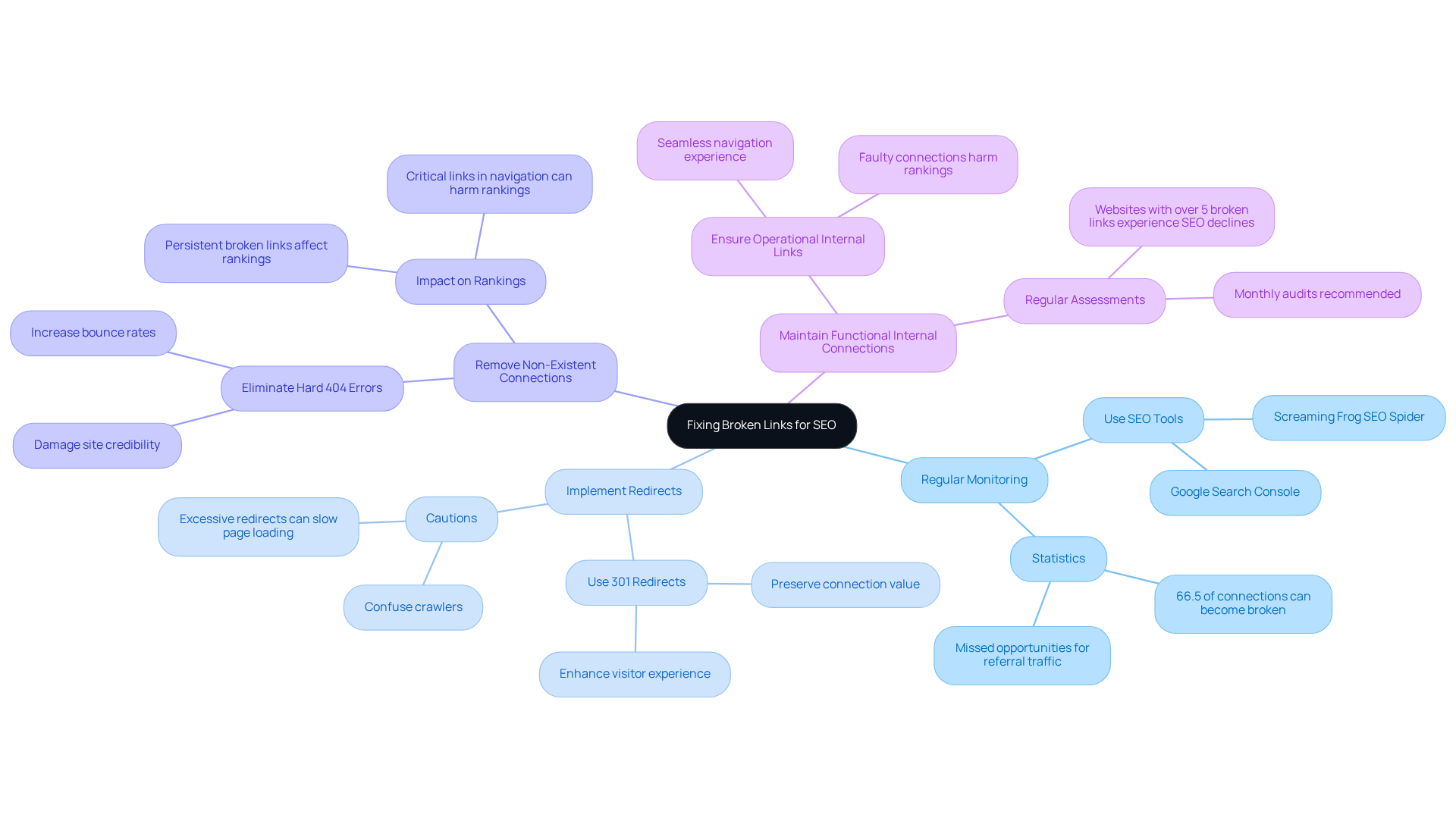
Conclusion
A well-crafted internal linking strategy stands as a cornerstone of success for DTC brands seeking to enhance their SEO performance and drive conversions. By effectively connecting related content, brands can significantly improve their website's crawlability, facilitating easier indexing and comprehension of site structure by search engines. This not only elevates search engine rankings but also streamlines navigation, guiding visitors through the sales funnel with greater efficiency.
The article delineates essential strategies, including:
- The use of descriptive anchor text
- The maintenance of a logical hierarchy
- The regular auditing of internal links to ensure relevance and functionality
It underscores the importance of linking to cornerstone content and utilizing topic clusters to foster a cohesive user experience. By implementing these best practices, DTC brands can markedly increase engagement metrics, reduce bounce rates, and ultimately enhance their conversion rates.
In conclusion, the significance of internal linking cannot be overstated. DTC brands are strongly encouraged to prioritize these strategies as integral components of their overall SEO efforts. By cultivating a well-structured internal linking framework, brands can not only improve their online visibility but also create a more engaging experience for their users. As the digital landscape continues to evolve, embracing effective internal linking practices will remain vital for achieving sustainable growth and success.
Frequently Asked Questions
Why is a robust internal linking strategy important for DTC brands?
A robust internal linking strategy is essential for DTC brands as it enhances website crawlability, improves search engine indexing, boosts search engine rankings, and facilitates better navigation, ultimately leading to higher conversion rates.
How does internal linking affect conversion rates?
Internal linking helps distribute link equity across important pages, significantly impacting conversion rates by lowering bounce rates and increasing the time visitors spend on the site, which are critical indicators of engagement.
What are some successful examples of internal linking strategies?
Successful examples include premium fashion brands that use detailed product descriptions and high-quality visuals, enhancing user experience and trust, which often results in increased sales due to improved navigation and accessibility.
What are some best practices for internal linking?
Best practices include using descriptive anchor text, connecting to high-priority pages, ensuring relevance, maintaining a natural flow, regularly auditing internal connections, and combining internal with external links.
How can I create a strong internal linking strategy for my website?
To create a strong internal linking strategy, identify key pages, map your website structure, analyze existing links, prioritize high-traffic pages, update your linking strategy regularly, and ensure all links are functional and relevant.
What tools can help analyze current internal linking structures?
Tools like Screaming Frog or Semrush can help audit your current internal linking structure by identifying orphaned pages and highlighting areas needing enhancement.
How often should I update my internal linking strategy?
You should continuously refine your linking approach based on performance metrics and regularly evaluate your internal linking strategy to ensure it remains effective as your content evolves.
What role does anchor text play in internal linking?
Descriptive and relevant anchor text provides context for linked pages, improving clarity and relevance for both users and search engines, which enhances user experience and SEO performance.
What is the recommended number of internal links per page?
It is recommended to limit the number of internal links on a single page to 2-5 links per 1,000 words to avoid overwhelming users and to ensure each link serves a clear purpose.
How can I monitor the performance of my internal links?
Regularly track the performance of your internal links using analytics tools to assess how well your links are driving traffic and engagement, allowing for data-driven adjustments to your strategy.
FAQs











